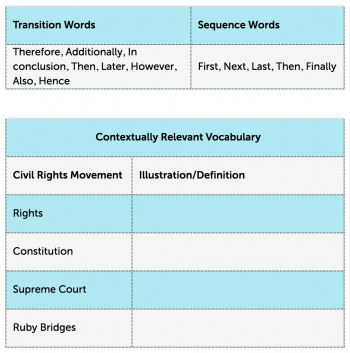What?
When?
Why?
How?
- Choose vocabulary words that are essential to student comprehension from the central text (such as Tier Two and Tier Three vocabulary, academic and domain-specific words, words deserving more attention, transition words and words likely to appear in future texts).
- Before the read aloud, spend time orally identifying additional contextually relevant words (e.g., the civil rights movement, rights, Constitution, Supreme Court, Ruby Bridges) with students.
- Create an anchor chart for on-going reference in the classroom.
- Use a manipulative to help students conceptualize new vocabulary through original illustration.
- Ask students to listen for the identified words while they listen to the read aloud.
- Return to the text. Ask students questions about the unknown vocabulary words and phrases. Encourage students to use context clues, when possible, to determine meaning.
- Add student answers and definitions to anchor chart. Clarify as necessary.
- Extend the learning throughout the week by:
- Guiding students to understand relationships between words (sort vocabulary words into categories, make real-life connections, recognize shades of meaning);
- Asking students to look and listen for vocabulary words in conversations, books, television shows and advertisements and to share these observations with the class;
- Requiring students to use the vocabulary words in conversations or writing.
English language learners
Explicitly teaching words supports language development, but using the word in context allows for a deeper level of understanding. English language learners benefit from the discussion that takes place among classmates to come to consensus the meaning of a new word meaning during the pre-reading oral presentation of the anchor chart. Verbalizing thoughts (as well as listening to others’ view points) provides a context for understanding new vocabulary.
Connection to anti-bias education
Previewing focuses students’ attention on specific information they will be responsible for learning, so all students can approach the text with the same foundational knowledge. This type of explicit instruction aims to narrow the achievement gap directly associated with vocabulary knowledge, development and access.
Sample anchor charts:
